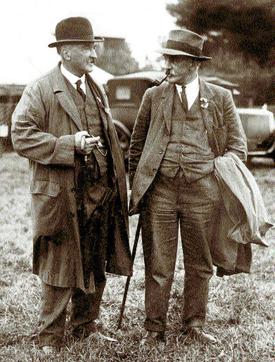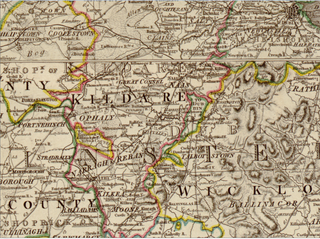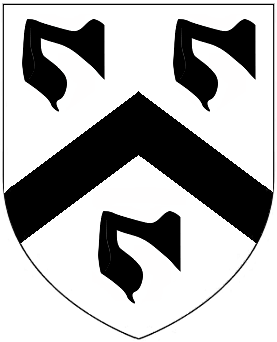Related Research Articles

The Rt. Hon. Standish O'Grady, 1st Viscount Guillamore, PC, from Cahir Guillamore, County Limerick, served as Lord Chief Baron of the Exchequer for Ireland for a number of years. He was created Viscount Guillamore by a patent of 28 January 1831.
This is a list of the High Sheriffs of Northamptonshire.

Thomas William Westropp Bennett was an Irish politician, magistrate and public figure in Irish agriculture.
The Lord High Treasurer of Ireland was the head of the Exchequer of Ireland, and chief financial officer of the Kingdom of Ireland. The designation High was added in 1695.
The High Sheriff of Clare was a High Sheriff title. Records show that the title was in existence from at least the late 16th century, though it is not used today in the modern Republic of Ireland. The title existed within County Clare in the west of Ireland during the time of the Kingdom of Ireland and then as part of the United Kingdom of Great Britain and Ireland.
The High Sheriff of Westmeath was the British Crown's judicial representative in County Westmeath, Ireland from its creation under The Counties of Meath and Westmeath Act 1543 until 1922, when the office was abolished in the new Free State and replaced by the office of Westmeath County Sheriff. The sheriff had judicial, electoral, ceremonial and administrative functions and executed High Court Writs. In 1908, an Order in Council made the Lord-Lieutenant the Sovereign's prime representative in a county and reduced the High Sheriff's precedence. However the sheriff retained his responsibilities for the preservation of law and order in the county. The usual procedure for appointing the sheriff from 1660 onwards was that three persons were nominated at the beginning of each year from the county and the Lord Lieutenant then appointed his choice as High Sheriff for the remainder of the year. Often the other nominees were appointed as under-sheriffs. Sometimes a sheriff did not fulfil his entire term through death or other event and another sheriff was then appointed for the remainder of the year. The dates given hereunder are the dates of appointment. The following is an incomplete list: all addresses are in County Westmeath unless stated otherwise.
The High Sheriff of Fermanagh is the Sovereign's judicial representative in County Fermanagh. Initially an office for lifetime, assigned by the Sovereign, the High Sheriff became annually appointed from the Provisions of Oxford in 1258. Besides his judicial importance, he has ceremonial and administrative functions and executes High Court Writs.
The High Sheriff of Carlow was the British Crown's judicial representative in County Carlow, Ireland from the 14th century until 1922, when the office was abolished in the new Free State and replaced by the office of Carlow County Sheriff. The sheriff had judicial, electoral, ceremonial and administrative functions and executed High Court Writs. In 1908, an Order in Council made the Lord-Lieutenant the Sovereign's prime representative in a county and reduced the High Sheriff's precedence. However, the sheriff retained his responsibilities for the preservation of law and order in the county. The usual procedure for appointing the sheriff from 1660 onwards was that three persons were nominated at the beginning of each year from the county and the Lord Lieutenant then appointed his choice as High Sheriff for the remainder of the year. Often the other nominees were appointed as under-sheriffs. Sometimes a sheriff did not fulfil his entire term through death or other event and another sheriff was then appointed for the remainder of the year. The dates given hereunder are the dates of appointment. All addresses are in County Carlow unless stated otherwise.
The High Sheriff of Queen's County was the British Crown's judicial representative in Queen's County, Ireland, Ireland from the 16th century until 1922, when the office was abolished in the new Free State and replaced by the office of Offaly County Sheriff. The sheriff had judicial, electoral, ceremonial and administrative functions and executed High Court Writs. In 1908, an Order in Council made the Lord-Lieutenant the Sovereign's prime representative in a county and reduced the High Sheriff's precedence. However, the sheriff retained his responsibilities for the preservation of law and order in the county. The usual procedure for appointing the sheriff from 1660 onwards was that three persons were nominated at the beginning of each year from the county and the Lord Lieutenant then appointed his choice as High Sheriff for the remainder of the year. Often the other nominees were appointed as under-sheriffs. Sometimes a sheriff did not fulfil his entire term through death or other event and another sheriff was then appointed for the remainder of the year. The dates given hereunder are the dates of appointment. All addresses are in Queen's County unless stated otherwise.
The High Sheriff of Louth was the Crown's representative for County Louth, a territory known as his bailiwick. Selected from three nominated people, he held his office for the duration of a year. He had judicial, ceremonial and administrative functions and executed High Court Writs.
The High Sheriff of County Kilkenny was the British Crown's judicial representative in County Kilkenny, Ireland from the 16th century until 1922, when the office was abolished in the new Free State and replaced by the office of Kilkenny County Sheriff. The sheriff had judicial, electoral, ceremonial and administrative functions and executed High Court Writs. In 1908, an Order in Council made the Lord-Lieutenant the Sovereign's prime representative in a county and reduced the High Sheriff's precedence. However, the sheriff retained his responsibilities for the preservation of law and order in the county. The usual procedure for appointing the sheriff from 1660 onwards was that three persons were nominated at the beginning of each year from the county and the Lord Lieutenant then appointed his choice as High Sheriff for the remainder of the year. Often the other nominees were appointed as under-sheriffs. Sometimes a sheriff did not fulfil his entire term through death or other event and another sheriff was then appointed for the remainder of the year. The dates given hereunder are the dates of appointment. All addresses are in County Kilkenny unless stated otherwise.
The High Sheriff of Kerry was the British Crown's judicial representative in County Kerry, Ireland from the 16th century until 1922, when the office was abolished in the new Free State and replaced by the office of Kerry County Sheriff. The sheriff had judicial, electoral, ceremonial and administrative functions and executed High Court Writs. In 1908, an Order in Council made the Lord-Lieutenant the Sovereign's prime representative in a county and reduced the High Sheriff's precedence. However, the sheriff retained his responsibilities for the preservation of law and order in the county. The usual procedure for appointing the sheriff from 1660 onwards was that three persons were nominated at the beginning of each year from the county and the Lord Lieutenant then appointed his choice as High Sheriff for the remainder of the year. Often the other nominees were appointed as under-sheriffs. Sometimes a sheriff did not fulfil his entire term through death or other event and another sheriff was then appointed for the remainder of the year. The dates given hereunder are the dates of appointment. All addresses are in County Kerry unless stated otherwise.
The High Sheriff of Limerick City was the Sovereign's judicial representative in the city of the City of Limerick. Initially an office for lifetime, assigned by the Sovereign, the High Sheriff became annually appointed from the Provisions of Oxford in 1258. Besides his judicial importance, he had ceremonial and administrative functions and executed High Court Writs. The office was abolished in 1920 on the formation of the Irish Free State.

The High Sheriff of Kildare was the British Crown's judicial representative in County Kildare, Ireland from the 16th century until 1922, when the office was abolished in the new Free State and replaced by the office of Kildare County Sheriff. The High Sheriff had judicial, electoral, ceremonial and administrative functions and executed High Court Writs. In 1908, an Order in Council made the Lord Lieutenant the Sovereign's prime representative in a county and reduced the High Sheriff's precedence. However, the sheriff retained his responsibilities for the preservation of law and order in the county. The usual procedure for appointing the sheriff from 1660 onwards was that three persons were nominated at the beginning of each year from the county and the Lord Lieutenant then appointed his choice as High Sheriff for the remainder of the year. Often the other nominees were appointed as under-sheriffs. Sometimes a sheriff did not serve his full term due to death or another event, and another sheriff was then appointed for the remainder of the year. The dates given in this article are the dates of appointment.
The High Sheriff of County Cork was the Sovereign's judicial representative in County Cork. Initially an office for lifetime, assigned by the Sovereign, the High Sheriff became an annual appointment following the Provisions of Oxford in 1258. Besides his judicial importance, the sheriff had ceremonial and administrative functions and executed High Court Writs.
The Sheriff of County Dublin was the Sovereign's judicial representative in County Dublin. Initially, an office for a lifetime, assigned by the Sovereign, the Sheriff became an annual appointment following the Provisions of Oxford in 1258. The first recorded Sheriff was Ralph Eure, appointed in that year. The next recorded Sheriff was Sir David de Offington, who was Sheriff in 1282. Besides his judicial importance, the sheriff had ceremonial and administrative functions and executed High Court Writs.
Sir Vere Hunt, 1st Baronet of Currah was an Irish politician, landowner and businessman. He is chiefly remembered for founding the village of New Birmingham in County Tipperary, for his ill-advised purchase of the island of Lundy, and for his entertaining diary. He was a colourful character, who was noted for his heavy drinking and gambling, but also for his intellectual interests, and his stern criticism of his own class.
The sheriff of the City of Cork is the court officer responsible for the enforcement of civil judgments in Cork county borough. The current sheriff is a solicitor, Martin A Harvey. Sheriffs earn their fees from poundage (commission). Before 1842 two sheriffs were voted into office annually by the freemen of the city. After that time, the power of appointment of a single sheriff per year was vested in the crown.
The Rt. Hon. Silver Oliver PC was an Irish landowner and Privy Counsellor politician who owned Castle Oliver in County Limerick, Ireland.

The Mansel family, also known throughout history as Mansell and Maunsell, is a British noble family.
References
- 1 2 3 4 5 6 7 8 9 10 11 12 13 14 15 16 17 18 19 20 21 22 23 24 25 26 27 28 29 30 31 32 33 34 35 36 37 38 39 40 41 42 43 44 45 46 47 48 49 50 51 52 53 54 55 56 57 58 59 60 61 62 63 64 65 66 67 68 69 70 71 72 73 74 75 76 77 78 79 80 81 82 83 84 85 86 87 88 89 90 91 92 93 94 95 96 97 98 99 100 101 102 103 104 105 106 107 108 109 110 111 112 113 114 115 116 117 118 119 120 121 122 123 124 125 126 127 128 129 130 131 132 133 134 135 136 137 138 139 140 141 142 143 144 145 146 147 148 149 150 151 152 153 154 155 156 157 158 159 160 161 162 163 164 165 166 167 168 169 170 171 172 173 174 175 176 177 178 179 180 181 182 183 184 185 186 187 188 189 190 191 192 193 194 195 196 Fitzgerald, Patrick. The history, topography, and antiquities, of the county and city of Limerick, Volume 2.
- ↑ Burke, John. History of the Extinct and Dormant Baronetcies of England Ireland and Scotland. p. 336. Google Books
- ↑ D'Alton, John. King James's Irish Army List. p. 761.
- 1 2 3 A genealogical and heraldic history of the landed gentry of Ireland, 1912, Bernard Burke
- ↑ Ferrar, John. The History of Limerick, Ecclesiastical, Civil and Military. p. 460.
- ↑ Complete Baronetage,p.377
- ↑ "Reference source: National Library of Ireland". National Library of Ireland. Retrieved 20 August 2012.
- 1 2 3 Complete Baronetage, p.414
- ↑ "ODELL, William (1752–1831), of Fortwilliam and the Grove, Rathkeale, co. Limerick". History of Parliament Online. Retrieved 7 May 2012.
- ↑ "OLIVER, Charles Silver (c.1763–1817), of Inchera, co. Limerick". History of Parliament Online. Retrieved 7 May 2012.
- ↑ "High Sheriffs, 1824". The Connaught Journal. 1 March 1824. Retrieved 10 May 2011.
- 1 2 3 "The heraldic calendar"
- 1 2 3 4 5 A genealogical and heraldic history of the landed gentry of Ireland
- ↑ "Late Col. FCT Gascigne" (PDF). Retrieved 23 August 2012.
- ↑ "Visitation of Ireland"
- ↑ A Genealogical and Heraldic History of the Landed Gentry of Great Britain by Sir Bernard Burke (page 75)
- ↑ Edward Walford. The county families of the United Kingdom
- 1 2 3 Kelly's Handbook to the Titled, Landed and Official Classes. 1916.